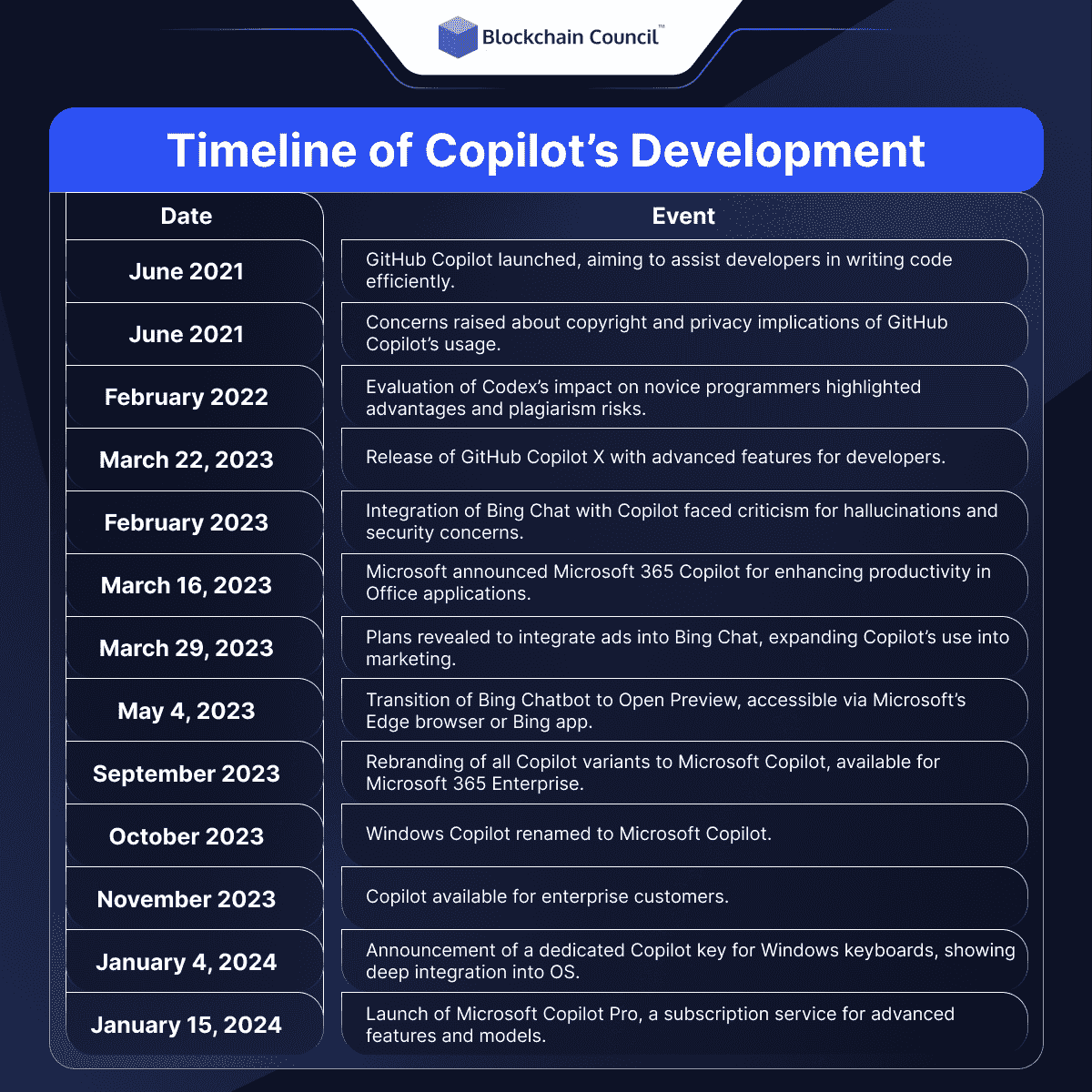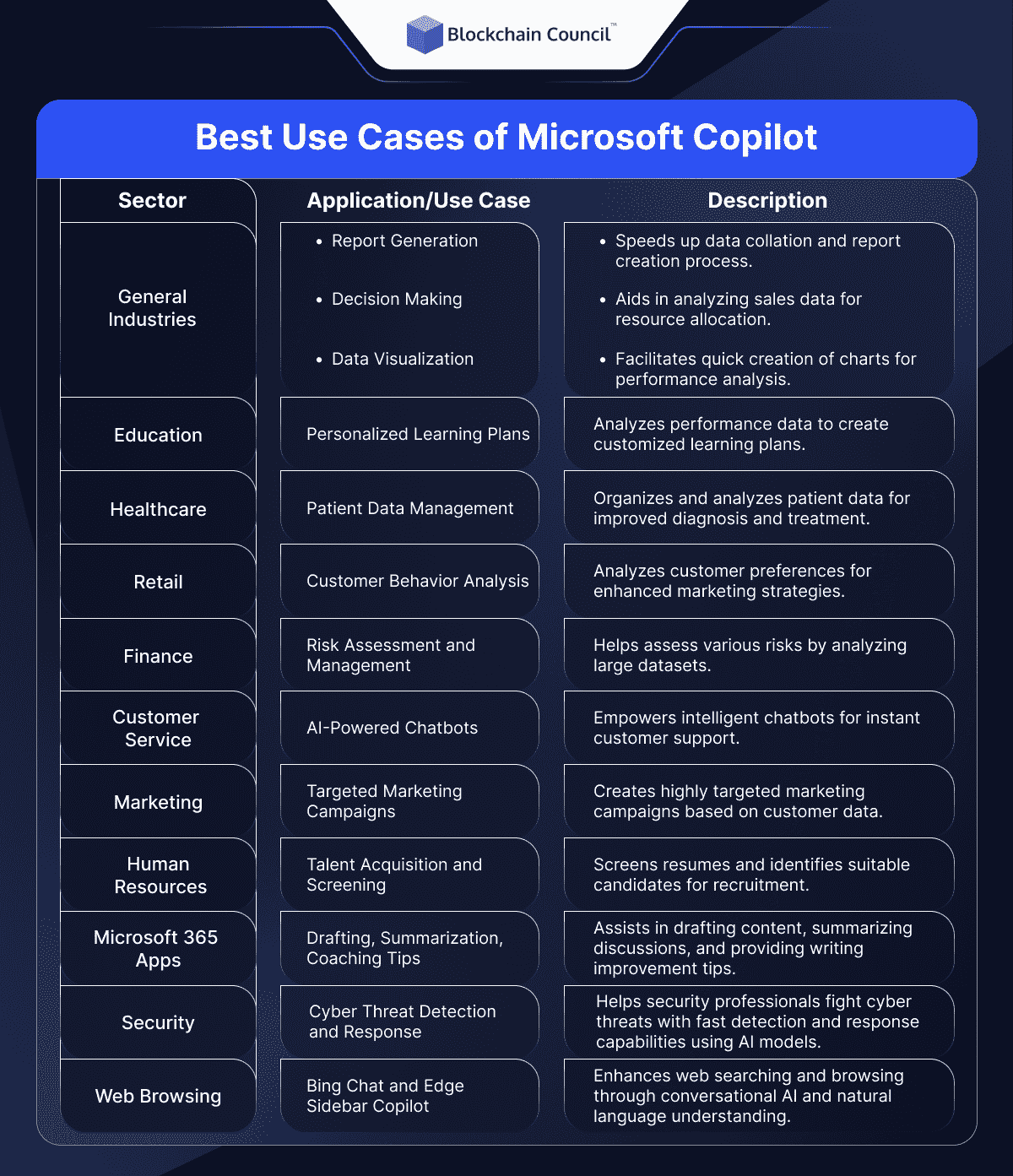
- Blockchain Council
- September 12, 2024
Summary
- Microsoft Copilot is an AI-powered assistant designed to boost productivity, creativity, and information management across Microsoft 365 and Windows.
- It replaces Cortana and operates on a freemium model, offering most features for free users and additional ones for paid subscribers.
- Copilot uses advanced AI to perform tasks such as summarizing emails, generating presentations, and creating content based on user prompts.
- It has been integrated deeply into the Windows operating system and emphasizes a seamless interaction between the user and AI across different devices and applications.
- Copilot learns new skills and is guided by AI principles and a Responsible AI Standard to ensure data security, compliance, and privacy.
- It operates on the Microsoft Prometheus model, combining Bing search capabilities with OpenAI’s GPT-4 and GPT-4 Turbo models.
- Copilot’s key features include Copilot Studio for customization, personalization options, Python integration in Excel, and collaboration enhancements in Microsoft Teams.It offers various capabilities such as smart app control, enhanced photo editing, and improved digital pen functionality in Windows 11.
- Users can get started with Copilot by signing into Microsoft 365, checking its availability in applications, accessing it in Teams, configuring settings, and leveraging learning resources.
- Copilot ensures security, compliance, and privacy by inheriting Microsoft 365’s policies, implementing additional safeguards for EU users, and maintaining strict privacy measures for customer data.
In the ever-evolving landscape of artificial intelligence (AI) and workplace innovation, Microsoft has taken a monumental leap forward with the introduction of Microsoft Copilot. Launched initially as a comprehensive AI companion within Microsoft’s ecosystem, Copilot has evolved significantly, embedding itself into a myriad of applications from Microsoft 365 to Windows.
This revolutionary tool is designed to act as your AI companion, streamlining tasks and fostering an environment where creativity and productivity flourish. But what exactly is Microsoft Copilot? Why does it stand out? Read till the end to find out what Microsoft Copilot is, how it works, what its key features are, and how you can get started with it!
What is Microsoft Copilot? Defined
At its core, Microsoft Copilot is an AI-powered assistant designed to enhance productivity, creativity, and information management across a wide range of Microsoft applications and services, including Microsoft 365 and Windows. The initiative behind Copilot is to offload the more tedious or complex tasks from the user, thereby boosting efficiency and allowing more room for creative and strategic thinking.
Copilot is Microsoft’s primary replacement for the discontinued Cortana and operates on a freemium model, offering most features for free users and additional features for paid subscribers under the name “Microsoft Copilot Pro”. Originally announced as an enhancement feature for Microsoft 365, the focus has been squarely on elevating business productivity.
The tool uses advanced AI to perform tasks like summarizing emails in Outlook on mobile devices, generating presentations in PowerPoint, or even creating content based on user prompts in Word. This broad application of AI seeks to transform how work is done, making it more intuitive and less time-consuming for users across various platforms, including mobile and desktop.
As part of its continuous evolution, Copilot has been integrated more deeply into the Windows operating system and rebranded under a unified Copilot logo, emphasizing its integral role across the Microsoft suite. This includes direct accessibility through the Windows taskbar and the introduction of voice command functionalities, indicating Microsoft’s vision of a more seamless interaction between the user and the AI across different devices and applications.
Microsoft Copilot is designed to learn new skills and is committed to building responsibly, guided by AI principles and a Responsible AI Standard to ensure data security, compliance, and privacy.
Also Read: What are the Applications of Reinforcement Learning (RL)?
Timeline of Copilot’s Development
How Does Microsoft Copilot Work?
The Microsoft Prometheus model is the driving engine of Copilot. It is an advanced AI framework that combines Microsoft’s Bing search capabilities with OpenAI’s GPT-4 and GPT-4 Turbo models.
The Prometheus model operates through a component known as the Orchestrator, which iteratively generates search queries. This process effectively merges the vast data and search results from Bing with the comprehensive understanding and generative capabilities of GPT models.
- Users provide prompts within Microsoft 365 apps, which Copilot preprocesses through grounding to enhance specificity.
- Copilot securely accesses and processes organizational data based on existing user access permissions, ensuring data privacy and security.
- The processed prompt is sent to LLMs for further processing, generating relevant and actionable responses tailored to the specific task.
- Copilot post-processes the LLM response, incorporating additional grounding calls to Microsoft Graph for further context and specificity.
Microsoft Graph is an API that evaluates context and Microsoft 365 user data, refining prompts before they are processed by the language model. The output is then contextually adjusted by Microsoft Graph before being delivered to the respective Microsoft application, ensuring that the generated content is tailored to the user’s specific needs and preferences.
This sophisticated interplay allows Copilot to provide contextually relevant, accurate, and creative outputs across various tasks. Whether it’s drafting emails, creating content, or generating images, Copilot’s underlying technology is designed to understand and adapt to the user’s needs in real-time, using both the breadth of the internet and the depth of its AI models.
Also Read: What is Claude AI?
Key Features and Capabilities of Microsoft Copilot
Microsoft Copilot Studio and Microsoft 365 Enhancements
- Copilot Studio: A low-code tool that enables customization of Copilot for Microsoft 365, allowing users to build and manage standalone copilots, custom GPTs, and connect to various data sources including SAP, Workday, and ServiceNow.
- Personalization: Copilot can now be tailored to individual roles and preferences, offering responses based on user-defined details like formatting, style, and tone.
- Python in Excel: Users can perform sophisticated mathematical analyses using Python, with the option to use natural language for commanding Copilot in Excel.
- Collaboration Features: Enhancements to collaboration include Copilot’s ability to participate fully in Microsoft Teams meetings, synthesize long posts, generate action items, and assist in Teams chats and channels.
Windows 11 Integration and AI Tools
- Snipping Tool Enhancements: Features text extraction and redaction, and audio capture support.
- Clipchamp Auto Compose: Offers scene suggestions and edits for video creation.
- Notepad Enhancements: Automatic session saving and restoration of unsaved content.
- Modernized Outlook and File Explorer: New functionalities for managing email accounts and a gallery feature for easier photo access.
Outlook and Productivity Tools
- Visual Data Representation: Copilot can now generate charts and summaries from data or notes within classic Outlook and other applications.
- Meeting Assistance without Recording: For enterprise users, Copilot can be used in meetings without the need to record or transcribe the session.
AI-Powered Features in Windows 11
- Smart App Control: Predicts the safety of downloading and running apps on Windows 11.
- Photos App: Enhanced editing capabilities for cropping, color, and lighting adjustments.
- Windows Ink: Improved digital pen functionality for drawing, designing, and navigating.
Microsoft 365 Apps Integration
- Teams Phone: Automates key administrative tasks during calls.
- Whiteboard and OneNote: Supports idea generation, organization, and drafting with natural language commands.
- Forms Creation: Eases the creation of surveys and polls.
Additional Copilot Capabilities
- File Summaries and Insights: Quick overviews and insights from files and video content, with natural language querying.
- Document Sharing Summaries: Automated summaries for shared documents to provide immediate context.
- Video Summaries in Stream: Quick summaries and insights from videos within Microsoft Stream.
Also Read: Gemini VS ChatGPT – What’s the Difference?
How to Get Started with Microsoft Copilot?
To get started with Microsoft Copilot, follow these steps:
Step 1: Sign In to Microsoft 365:
- Start by signing into your Microsoft 365 account. If your organization has already set up Microsoft Copilot, you should have access to it through your Microsoft 365 apps.
Step 2: Check Copilot Availability:
- Ensure that Microsoft Copilot is available for your Microsoft 365 applications such as Word, Excel, PowerPoint, Outlook, and Teams.
- Copilot should be accessible if your organization has assigned a license to you.
Step 3: Accessing Copilot in Microsoft Apps:
- Within the Microsoft 365 desktop apps or web versions, look for Copilot features.
- In apps like Word or Outlook, Copilot can assist with creating content, summarizing emails, and more.
Step 4: Use Copilot in Teams:
- If you’re using Microsoft Teams, ensure you have the Teams desktop or web client installed.
- Copilot can help manage meeting content, including transcription and summarization.
Step 5: Get OneDrive Account:
- Make sure you have an active OneDrive account.
- Copilot leverages OneDrive for saving and sharing documents and files it helps create or edit.
Step 6: Configure Copilot Settings:
- Visit the Microsoft 365 admin center to configure settings for Copilot, if you have administrative access.
- Here, you can manage license assignments and configure data security and privacy settings.
Step 7: Leverage Learning Resources:
- To get the most out of Copilot, consider exploring the official learning paths and modules available on Microsoft Learn.
- These resources are designed to enhance your understanding and efficient use of Copilot across various applications.
Step 8: Review and Adjust Privacy Settings:
- It’s important to review your privacy settings within Microsoft 365 Apps as they may affect the availability and functionality of Copilot features.
Best Use Cases of Microsoft Copilot
Also Read: What is AI Dungeon?
Security, Compliance, and Privacy
When it comes to Microsoft Copilot, security, compliance, and privacy are paramount considerations. Here’s how Microsoft ensures these aspects are addressed:
- It is integrated into Microsoft 365, thereby inheriting all of Microsoft 365’s security, compliance, and privacy policies. This includes two-factor authentication, compliance boundaries, privacy protections, and more, making it a trustworthy AI solution for users.
- Administrators have the ability to manage and secure data through tools such as Content Search or Microsoft Purview. They can set retention policies for data related to chat interactions with Copilot, ensuring that sensitive information is handled appropriately. Additionally, users can delete their interaction history with Copilot, providing control over their data privacy.
- Microsoft has implemented additional safeguards for European Union (EU) users to comply with the EU Data Boundary. Traffic from the EU stays within the region, although it can also be routed to other regions during high utilization periods under strict compliance measures. Furthermore, Microsoft’s Advanced Data Residency (ADR) and Multi-Geo Capabilities ensure data residency commitments for all customers.
- The web content plugin feature of Copilot enhances responses with information from the web while maintaining privacy and compliance standards. This feature can be managed by administrators and users, ensuring that external data integration complies with organizational policies.
- Moreover, Microsoft Copilot runs queries as the user, maintaining the same level of privileges as the user, thus ensuring that it adheres to privacy and security protocols. Customer data shared with Microsoft for improving Copilot’s system and AI models is handled with strict privacy measures, ensuring that it is not shared with third parties, used for sales, or used to train foundational AI models.
Conclusion
In conclusion, Microsoft Copilot has emerged as a pivotal element in the landscape of AI-driven tools. It sets a new benchmark for how technology can enhance human capabilities in the digital era. As Copilot continues to evolve, with over 5 billion interactions marking its journey thus far, its role in shaping the future of AI assistance is unequivocal.
Offering a glimpse into the potential of AI to empower individuals and organizations, Microsoft Copilot stands as a testament to the transformative power of technology when harnessed with user-centric innovation and accessibility at its core. As we look forward, the journey of Copilot reflects the boundless possibilities of AI, promising a future where technology and human ingenuity converge to unlock new horizons.
Frequently Asked Questions
What is Microsoft Copilot and how does it work?
- Microsoft Copilot is an AI-powered assistant designed to enhance productivity and creativity across various Microsoft applications.
- It works by using the Microsoft Prometheus model, which combines Bing search capabilities with OpenAI’s GPT-4 and GPT-4 Turbo models.
- Copilot operates through an Orchestrator component that generates search queries and merges data from Bing with generative capabilities of GPT models.
- Users provide prompts within Microsoft 365 apps, and Copilot processes them, accesses organizational data securely, and generates relevant responses tailored to the specific task.
- It post-processes responses, incorporating additional context from Microsoft Graph before delivering them to the respective Microsoft application.
What are the key features of Microsoft Copilot?
- Copilot Studio: A low-code tool for customization and management of Copilot, including connecting to various data sources.
- Personalization: Copilot can be tailored to individual roles and preferences, offering responses based on user-defined details like formatting and style.
- Integration with Microsoft 365 apps: Copilot assists in drafting content, summarizing emails, and managing meeting content in Teams.
- Windows 11 integration: Enhanced features in Windows 11 include snipping tool enhancements, Clipchamp Auto Compose, and Notepad enhancements.
- AI-powered capabilities: Copilot can generate charts from data, assist in decision-making, aid in customer behavior analysis, and more.
How can users get started with Microsoft Copilot?
- Sign in to Microsoft 365: Users need to sign in to their Microsoft 365 account to access Copilot.
- Check availability: Ensure Copilot is available for Microsoft 365 applications such as Word, Excel, PowerPoint, Outlook, and Teams.
- Access Copilot in apps: Look for Copilot features within Microsoft 365 desktop apps or web versions to start using its functionalities.
- Use Copilot in Teams: Install the Teams desktop or web client to leverage Copilot’s features for managing meeting content.
- Configure settings: Admins can configure Copilot settings through the Microsoft 365 admin center to manage license assignments and data security.
How does Microsoft ensure security and privacy with Copilot?
- Copilot inherits Microsoft 365’s security, compliance, and privacy policies, including two-factor authentication and privacy protections.
- Admins can manage and secure data through tools like Content Search or Microsoft Purview, setting retention policies for chat interactions with Copilot.
- Microsoft implements additional safeguards to comply with the EU Data Boundary, ensuring data residency commitments.
- External data integration through Copilot’s web content plugin is managed by administrators and users, adhering to organizational policies.
- Copilot runs queries as the user, maintaining the same level of privileges, and ensures strict privacy measures for customer data shared with Microsoft.







































































 Guides
Guides News
News Blockchain
Blockchain Cryptocurrency
& Digital Assets
Cryptocurrency
& Digital Assets Web3
Web3 Metaverse & NFTs
Metaverse & NFTs
